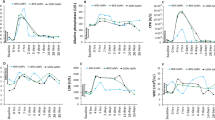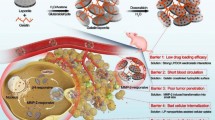Abstract
Purpose
The feasibility of using magnetic targeted carriers (MTC) to deliver doxorubicin intravesically was studied in normal swine bladder. MTCs are microparticles consisting of metallic iron and activated carbon. Doxorubicin is adsorbed to the activated carbon component of the MTCs (MTC-DOX) while the iron component provides magnetic susceptibility. This technology is designed for site-specific delivery of a drug to a tumor in the presence of an externally applied magnetic field in order to achieve prolonged release of high localized drug concentrations by retention of MTCs in the region of interest. An intravesical route of administration was evaluated as intravesical chemotherapy is used in the treatment of bladder cancer.
Methods
The urethras of six swine were catheterized and Foley catheters were placed in their bladders. The effects of doses ranging from 10 to 80 mg doxorubicin adsorbed onto 300 to 800 mg MTCs were studied. A 30-min period of magnetic targeting immediately followed dosing, in which an external magnet was placed on the skin surface over a predetermined site on the bladder. The subsequent retention and distribution of test material was evaluated by measurement of doxorubicin levels in plasma and histopathological examination of the bladder following treatment. Blood samples were taken prior to treatment and at 15 and 30 min after infusion for measurement of doxorubicin. The bladder was drained and rinsed thoroughly following the procedure.
Results
Plasma doxorubicin concentrations were less than the assay limit of detection (10 ng/ml) during the 30 min following dosing. MTCs were found within the bladder walls, predominantly at the targeted site where they were present at greater depths within the layers of the epithelium. The study results show that MTC-DOX can be targeted and retained within specific locations in the bladder using magnetic targeting.
Conclusions
MTC delivery may allow greater exposure and specific deposition of drug at a defined site over intravesical administration of doxorubicin alone. The feasibility of this novel method of drug delivery was demonstrated and the results support further study for its potential use in treating bladder cancer.







Similar content being viewed by others
References
American Cancer Society (2002) Cancer facts and figures 2002. American Cancer Society, Atlanta, p 16
Bollen PJA, Hansen AK, Rasmussen HJ (2000) The laboratory swine. CRC Press, New York, p 89
Dalmose AL, Hvistendahl JJ, Olsen LH, Eskild-Jensen A, Djurhuus JC, Swindle MM (2000) Surgically induced urologic models in swine. J Invest Surg 13:133
Edsmyr F, Berlin T, Boman J, Duchek M, Esposti PL, Gustafsson H, Wijkstrom H, Collste LG (1980) Intravesical therapy with adriamycin in patients with superficial bladder tumors. Eur Urol 6:132
Flamm J, Grof F (1985) Prophylactic use of topical adriamycin after transurethral resection of transitional cell bladder tumours. Int Urol Nephrol 17:143
Goodwin SC, Peterson CL, Hoh C, Bittner CA (1999) Targeting and retention of magnetic targeted carriers (MTCs) enhancing intra-arterial chemotherapy. J Magn Magn Mater 194:132
Goodwin SC, Bittner CA, Peterson CL, Wong G (2001) Single-dose toxicity study of hepatic intra-arterial infusion of doxorubicin coupled to a novel magnetically targeted drug carrier. Toxicol Sci 60:177
Huncharek M, Geschwind JF, Witherspoon B., McGarry R, Adcock D (2000) Intravesical chemotherapy prophylaxis in primary superficial bladder cancer: a meta-analysis of 3703 patients from 11 randomized trials. J Clin Epidemiol 553:676
Mostofi FK (1974) International histological classification of tumors. A report by the Executive Committee of the International Council of Societies of Pathology. Cancer 33:1480
Wientjes MG, Badalament RA, Au JL-S (1996) Penetration of intravesical doxorubicin in human bladders. Cancer Chemother Pharmacol 37:539
Author information
Authors and Affiliations
Corresponding author
Rights and permissions
About this article
Cite this article
Leakakos, T., Ji, C., Lawson, G. et al. Intravesical administration of doxorubicin to swine bladder using magnetically targeted carriers. Cancer Chemother Pharmacol 51, 445–450 (2003). https://doi.org/10.1007/s00280-003-0597-9
Received:
Accepted:
Published:
Issue Date:
DOI: https://doi.org/10.1007/s00280-003-0597-9




